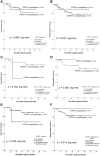Association Between Fibroblast Growth Factor Receptor 1 Gene Amplification and Human Papillomavirus Prevalence in Tonsillar Squamous Cell Carcinoma With Clinicopathologic Analysis
- PMID: 29553868
- PMCID: PMC6055260
- DOI: 10.1369/0022155418761652
Association Between Fibroblast Growth Factor Receptor 1 Gene Amplification and Human Papillomavirus Prevalence in Tonsillar Squamous Cell Carcinoma With Clinicopathologic Analysis
Abstract
Amplification of fibroblast growth factor receptor 1 ( FGFR1) has been reported in many squamous cell carcinomas, and human papillomavirus (HPV)-related oropharyngeal squamous cell carcinoma has been characterized as a distinct subset with favorable prognosis. Here, we investigated the FGFR1 amplification and HPV status in tonsillar squamous cell carcinoma (TSCC) and analyzed the clinical characteristics. HPV in situ hybridization (HPV ISH) and FGFR1 fluorescence in situ hybridization (FISH) were performed using tissue microarray from 89 cases of TSCC. Fourteen of 89 (15.7%) TSCC cases had FGFR1 amplification, and HPV was detected in 59 of 89 (66.3%) cases. FGFR1 amplification status was not associated with HPV positivity ( p=0.765). Outcomes were not significantly different between FGFR1 amplified and non-amplified patients. Although FGFR1 amplified patients ( n=4) in the HPV ISH-negative group ( n=30) had a tendency for poorer overall survival, no statistical significance was identified ( p=0.150, log-rank). FGFR1 protein overexpression showed better disease-free survival ( p=0.031, log-rank) in HPV-negative TSCC. This study suggests FGFR1 amplification may be important in the pathogenesis of TSCC regardless of HPV status.
Keywords: fibroblast growth factor receptor 1; fluorescence in situ hybridization; human papillomavirus; squamous cell carcinoma; tonsil.
Conflict of interest statement
Figures





Similar articles
-
Frequent hepatocyte growth factor overexpression and low frequency of c-Met gene amplification in human papillomavirus-negative tonsillar squamous cell carcinoma and their prognostic significances.Hum Pathol. 2014 Jul;45(7):1327-38. doi: 10.1016/j.humpath.2014.03.003. Epub 2014 Mar 26. Hum Pathol. 2014. PMID: 24810547
-
Overexpression of FGFR3 in HPV-positive Tonsillar and Base of Tongue Cancer Is Correlated to Outcome.Anticancer Res. 2018 Aug;38(8):4683-4690. doi: 10.21873/anticanres.12774. Anticancer Res. 2018. PMID: 30061236
-
Survival outcome of tonsillar squamous cell carcinoma (TSCC) in the context of human papillomavirus (HPV): A systematic review and meta-analysis.Surgeon. 2019 Feb;17(1):6-14. doi: 10.1016/j.surge.2018.04.009. Epub 2018 May 26. Surgeon. 2019. PMID: 29843958
-
Molecular subclassification determined by human papillomavirus and epidermal growth factor receptor status is associated with the prognosis of oropharyngeal squamous cell carcinoma.Hum Pathol. 2016 Apr;50:51-61. doi: 10.1016/j.humpath.2015.11.001. Epub 2015 Nov 17. Hum Pathol. 2016. PMID: 26997438
-
Human papillomavirus and tonsillar and base of tongue cancer.Viruses. 2015 Mar 20;7(3):1332-43. doi: 10.3390/v7031332. Viruses. 2015. PMID: 25803099 Free PMC article. Review.
Cited by
-
Molecular alterations of low-grade gliomas in young patients: Strategies and platforms for routine evaluation.Neurooncol Pract. 2021 Aug 23;8(6):652-661. doi: 10.1093/nop/npab053. eCollection 2021 Dec. Neurooncol Pract. 2021. PMID: 34777834 Free PMC article. Review.
-
It Takes Two to Tango: A Review of Oncogenic Virus and Host Microbiome Associated Inflammation in Head and Neck Cancer.Cancers (Basel). 2022 Jun 25;14(13):3120. doi: 10.3390/cancers14133120. Cancers (Basel). 2022. PMID: 35804891 Free PMC article. Review.
-
Therapeutic Targeting of FGFR Signaling in Head and Neck Cancer.Cancer J. 2022 Sep-Oct 01;28(5):354-362. doi: 10.1097/PPO.0000000000000615. Cancer J. 2022. PMID: 36165723 Free PMC article.
References
Publication types
MeSH terms
Substances
LinkOut - more resources
Full Text Sources
Other Literature Sources
Miscellaneous

